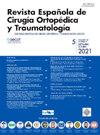[Artículo traducido] El índice de comorbilidad de Charlson ajustado por la edad en las fracturas acetabulares de los pacientes ancianos
Q3 Medicine
Revista Espanola de Cirugia Ortopedica y Traumatologia
Pub Date : 2025-07-01
DOI:10.1016/j.recot.2025.04.011
引用次数: 0
Abstract
Objective
This study aimed to analyze factors of comorbidity in older patients with acetabular fracture to know the role of disease in the treatment of this population.
Methods
Design retrospective cohort study.
Setting
Single Level 2 Trauma Center.
Patient selection criteria
A prospective database of acetabular fractures in patients over 55 years between January 2011 and January 2021 was studied. The exclusion criteria were age, pathological fracture, associated pelvic or hip fracture, follow-up of less than one year, and not having a computed tomography.
Outcome measures and comparisons
Patients were categorised as low (0-2), intermediate (3-4) or high (≥5) risk according to the age-adjusted Charlson comorbidity index (ACCI). The primary outcomes were risk of complications, number of complications and mortality at one year according to the ACCI scale. The difference between the pre-fracture Clinical Frailty Scale (CFS) and the one-year follow-up was also analysed. Descriptive and multivariable regression analyses were performed and ROC curves were constructed.
Results
A total of 119 patients with acetabular fracture were collected. Ninety-eight out of those met inclusion criteria for our study. In regard to ACCI groups, 22% were low-risk, 26% were intermediate-risk, and 52% were high-risk. Statistically significant differences were found according to age, sex, mechanism of injury, treatment type, surgical treatment type, Clinical Frailty Scale (CFS) score, readmissions, complications, and mortality. ROC curves showed an association between ACCI and CFS in terms of complications and mortality, with the exception of unadjusted Charlson comorbidity index. On the multivariable regression analysis, associations were found between ACCI and presence of complications (OR 1.37; 95%: CI 1.06-1.77; P=.015) and mortality (OR: 1.32; 95% CI: 1.04-1.67; P=.025) and between CFS and complications (OR: 2.01; 95% CI: 1.30.3.11; P=.001) and mortality (OR: 1.59; 95% CI: 1.08.2.35; P=.019). No statistical correlation was established between ASA and complications or mortality.
Conclusion
Presurgical ACCI and CFS scales may serve as a risk assessment method in treatment decision-making for patients with acetabular fracture. An association is observed between patients with a pre-fracture ACCI score ≥5 (high-risk) and a pre-fracture CFS score >4 (mild frailty) and mortality and complications at one year.
老年患者髋部骨折的年龄调整Charlson共病指数
目的分析老年髋臼骨折患者合并症的影响因素,了解疾病在老年髋臼骨折患者治疗中的作用。方法设计回顾性队列研究。单人2级创伤中心。患者选择标准研究了2011年1月至2021年1月期间55岁以上患者髋臼骨折的前瞻性数据库。排除标准为年龄、病理性骨折、相关骨盆或髋部骨折、随访时间少于一年、未进行计算机断层扫描。根据年龄校正Charlson合并症指数(ACCI),将患者分为低(0-2)、中(3-4)或高(≥5)风险。根据ACCI量表,主要结局是并发症的发生风险、并发症数量和一年内的死亡率。分析骨折前临床虚弱量表(CFS)与1年随访的差异。进行描述性和多变量回归分析,并绘制ROC曲线。结果共收集髋臼骨折患者119例。其中98人符合我们研究的纳入标准。ACCI组低危22%,中危26%,高危52%。年龄、性别、损伤机制、治疗方式、手术方式、临床虚弱量表(CFS)评分、再入院率、并发症、死亡率差异均有统计学意义。ROC曲线显示ACCI与CFS在并发症和死亡率方面存在相关性,但未调整的Charlson合并症指数除外。在多变量回归分析中,发现ACCI与并发症存在相关(OR 1.37;95%: ci 1.06-1.77;P= 0.015)和死亡率(OR: 1.32;95% ci: 1.04-1.67;P= 0.025)和CFS与并发症之间的差异(OR: 2.01;95% ci: 1.30.3.11;P= 0.001)和死亡率(OR: 1.59;95% ci: 1.08.2.35;P = .019)。ASA与并发症或死亡率之间没有统计学相关性。结论术前ACCI和CFS评分可作为髋臼骨折患者治疗决策的风险评估方法。骨折前ACCI评分≥5(高危)和骨折前CFS评分>;4(轻度虚弱)的患者与1年死亡率和并发症之间存在关联。
本文章由计算机程序翻译,如有差异,请以英文原文为准。
求助全文
约1分钟内获得全文
求助全文
来源期刊

Revista Espanola de Cirugia Ortopedica y Traumatologia
Medicine-Surgery
CiteScore
1.10
自引率
0.00%
发文量
156
审稿时长
51 weeks
期刊介绍:
Es una magnífica revista para acceder a los mejores artículos de investigación en la especialidad y los casos clínicos de mayor interés. Además, es la Publicación Oficial de la Sociedad, y está incluida en prestigiosos índices de referencia en medicina.
 求助内容:
求助内容: 应助结果提醒方式:
应助结果提醒方式:


